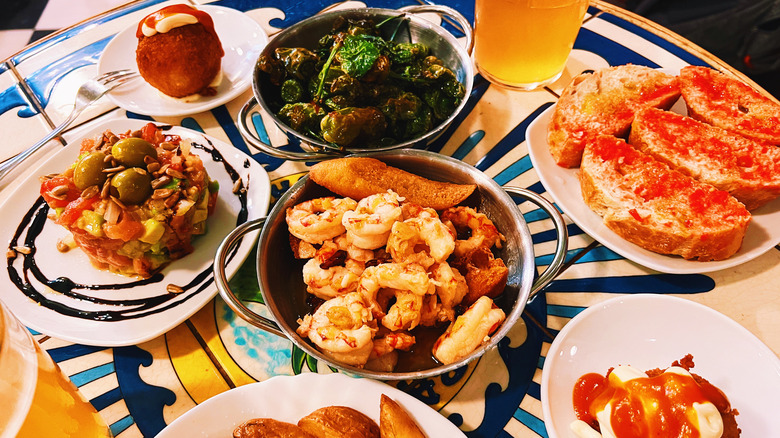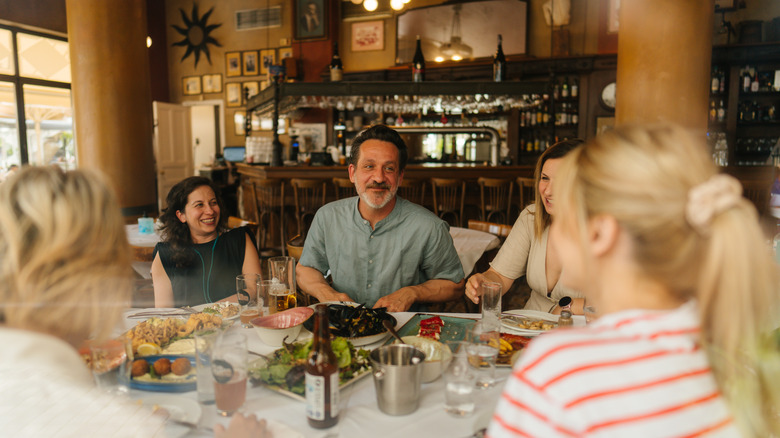Order This Type Of Food In Europe To Save Money While Tasting More, Per Rick Steves
One of the best parts of traveling to different countries is the food. Of course, the monuments, ruins, art, and architecture are great, but the sense memory of that plate of fresh seafood you had while visiting the island of Hydra in Greece or the perfect caprese salad with fresh basil you had in Montepulciano in Italy is hard to beat. You wish you could stay forever and have a different dish for every meal. Travel pro Rick Steves has a great tip for you while traveling in Europe to save a bit of money and taste more of the local cuisine: Order a buffet of appetizers or first courses. As Steves says on his website, "They're filling, less expensive, and more typically local than entrees."
Getting the real feel of the place you're staying isn't just the ingredients. Steves explains, "The best dining experiences are sensory, where you're not only eating tasty cuisine; you're also enjoying the patina of age, the colorful clientele and their chatter, and the crunchy sound of knives cutting through freshly baked loaves of bread." It's not about hitting the Michelin star restaurants or spending a lot of money. It's about sampling the things that the locals love, experiencing something new, and getting a glimpse of what it's like to live there day to day.
How to find the best spots for ordering appetizers
Steves recommends several small dishes at a time instead of one big one, reminding us that we may already know terms for this, like tapas in Spain, mezedes in Greece, and antipasti in Italy. You might even do this already at restaurants in your hometown. While the difference in price can be dependent on what type of entree you order, the same amount of money can usually get you several things. For instance, we looked at Antica Trattoria Papei in Siena, Italy. There you can get appetizers like bruschetta with tomatoes, hot fettunta, or chicken liver paté crostini for a little over $5 each, while the main dishes or second courses are between $13 and $22 each. Three or four different dishes instead of one is a pretty good deal.
In addition, Steves says he likes to try daily specials or regional specialties so he can really get a feel for what locals enjoy. To find the right place, you can ask one of those locals. He also offers this advice: "You'll find the most authentic dining places have a small selection on a handwritten menu in the native language. The menu's small because they're going to cook up just what they can sell out for the day." These places use local ingredients that are fresh that day, and Steves mentions that sometimes the chef will even come out to enjoy the happiness their cooking gives customers.
Other dining suggestions from Rick Steves
If you're traveling and dining on a shoestring budget, Steves has plenty of recommendations. One type of spot may look familiar, and that is a market hall. He mentions Florence's Mercato Centrale, which is like a food court meets a farmer's market, with a number of vendors sharing the same building. You pay separately at each one for carry-out, or to eat right there at the tables. It's a great idea if you want to try different types of food from different vendors at the same meal. "All over Europe, Industrial Age glass-and-steel farmers markets are getting a new lease on life as trendy food halls," Steves says. "They still come with the farmers market dimension, but they've been spiced up with great eateries, priced for local shoppers and serving the freshest ingredients." It's also a great idea if you have a few picky eaters in the family. There is so much variety that even your most demanding eater will probably find something.
Cafeterias are another idea for an inexpensive place to eat. One Steves recommends is in Coimbra, Portugal, at the local university (founded in 1290) where the food is great and won't break the bank. It may not be fancy, but you'll have variety and a chance to do something out of the ordinary. One final tip from us is to take a local cooking class in your country of choice so you can bring your new food knowledge home to America.


